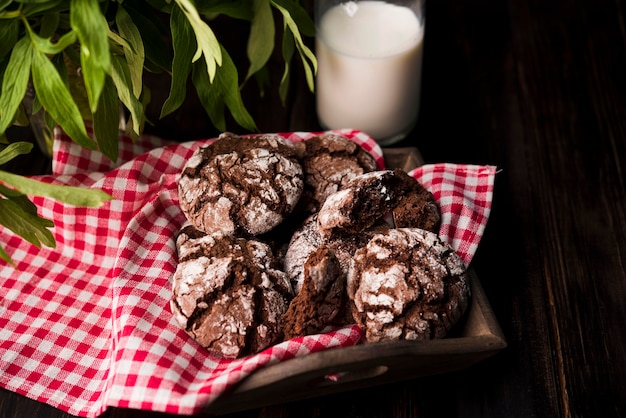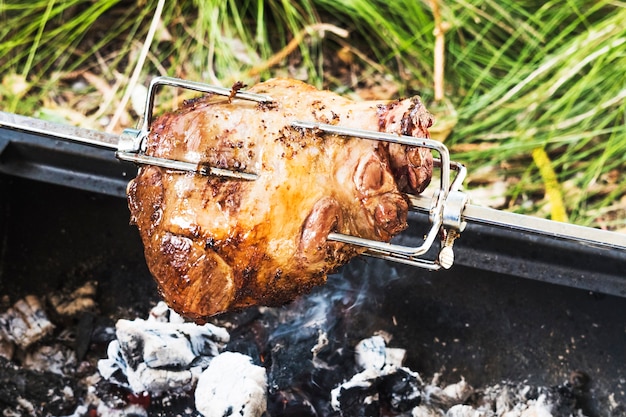As a self-proclaimed grilling aficionado, I've spent countless hours over a smoldering grill, experimenting with different techniques, seeking that elusive culinary perfection. And while I've mastered burgers, hot dogs, and even the occasional portobello mushroom, there's something about grilling a succulent filet mignon that truly gets my adrenaline pumping. It's a dish that requires both meticulous precision and a touch of artistry, and when executed flawlessly, it's an absolute culinary triumph. So, grab your tongs, fire up the grill, and let's embark on this journey together, uncovering the secrets to grilling the perfect filet mignon, from choosing the ideal cut to mastering the art of searing and resting.
(Part 1) choosing the right cut: A Foundation of Flavor

The Importance of Quality: A Culinary Canvas
Think of a filet mignon as a blank canvas – you can't expect a masterpiece from a cheap, flimsy canvas, can you? The same principle applies to your steak. Start with a high-quality cut, ideally graded as "Choice" or even better, "Prime." Look for a piece with a good marbling, those beautiful streaks of fat that translate to rich flavor and incredible tenderness. Avoid cuts that are too lean, as they can dry out during grilling.
Thickness is King: A Juicy, Tender Result
Now, let's talk thickness. I'm a firm believer in a filet mignon that's at least 1.5 inches thick, maybe even a little more. This allows for even cooking and ensures that you end up with a steak that's juicy and tender throughout. Anything thinner than that can cook too quickly, risking overcooked edges and a dry center. You want to be able to slice into that steak and see a beautiful, rosy-pink center.
(Part 2) Preparing the Filet Mignon: Laying the Groundwork

Patting Dry: The Secret to a Crispy Crust
Before you even think about the grill, give your filet mignon a thorough pat-down with paper towels. This might seem like a small step, but it's crucial for achieving that gorgeous, crispy crust. Excess moisture on the surface of the meat will create steam instead of a sear, and you'll lose that delicious crust. Trust me, it's a game-changer!
Seasoning: Simple is Best
Now, it's time to let those flavors sing. While I'm tempted to go crazy with fancy spice blends, I've learned that simple is often best when it comes to seasoning filet mignon. A generous sprinkle of kosher salt and freshly ground black pepper is all you need to enhance the natural flavor of the steak. Don't go overboard with spices – you don't want to mask the delicate, beefy flavor. However, if you're feeling adventurous, I like to add a pinch of smoked paprika for a touch of smoky depth or a whisper of garlic powder for a subtle savory note.
Let It Rest: A Moment of Patience
Once you've seasoned your filet mignon, let it sit at room temperature for about 30 minutes. This is a crucial step that many overlook. Allowing the steak to come up to room temperature ensures more even cooking. It also gives the flavors a chance to meld and deepen, creating a more complex taste. Just remember to remove it from the refrigerator about 30 minutes before you plan to start grilling.
(Part 3) Getting Your Grill Ready: The Foundation of Success

Cleaning is Key: A Spotless Canvas
Before you fire up the grill, take a moment to give it a good cleaning. Remove any leftover debris from previous grilling sessions, especially those pesky, burnt bits that can impart unwanted flavors to your precious filet mignon. A clean surface is essential for a truly delicious steak. I recommend using a grill brush to remove any stubborn remnants of food.
Heating Up: The Importance of Hot Grilling
A screaming hot grill is the secret to achieving that perfect sear and locking in those juicy flavors. Aim for a temperature between 450-550°F (232-288°C). A gas grill is ideal for this purpose, as you can easily control the heat and maintain it consistently. However, if you're using a charcoal grill, be prepared to tend the coals and adjust them throughout the cooking process to maintain the optimal temperature.
(Part 4) Grilling the Filet Mignon: A Masterclass in Technique
Searing: The Art of Creating a Delicious Crust
With your grill piping hot, place the filet mignon directly over the heat source. This is called searing, and it's the foundation of a phenomenal steak. You want to achieve a beautiful, caramelized crust that's crispy and flavorful. Aim for 2-3 minutes per side, flipping it only when a nice brown crust has formed. Resist the urge to flip too early – patience is key here. Allow the sear to develop properly, and you'll be rewarded with a flavor explosion in every bite.
Indirect Heat: Achieving Even Cooking
Now, we want to move our steak away from that intense direct heat. Once your filet mignon is seared, it's time to transfer it to the indirect heat section of your grill. This ensures that it cooks evenly without overcooking and that beautiful, juicy pink center remains intact. If you're using a gas grill, simply turn off the burners on one side and move the filet mignon to that side. If you're using a charcoal grill, move the coals to one side and place the filet mignon over the remaining unlit area. You'll be amazed at how this simple step changes the game.
Monitoring the Temperature: The Key to Perfect Doneness
The most accurate way to ensure perfect doneness is to use a meat thermometer. It's an absolute must-have for any serious griller. Insert it into the thickest part of the filet mignon, making sure it doesn't touch any bones. Then, check it regularly to ensure your steak is cooked to your liking. Here are some recommended internal temperatures:
| Doneness | Internal Temperature (°F) | Internal Temperature (°C) |
|---|---|---|
| Rare | 125-130 | 52-54 |
| Medium-Rare | 130-135 | 54-57 |
| Medium | 140-145 | 60-63 |
| Medium-Well | 150-155 | 65-68 |
| Well-Done | 160 | 71 |
Remember, these are just guidelines, and personal preference plays a crucial role. If you like your filet mignon a bit more pink or a bit more cooked, adjust the temperatures accordingly.
(Part 5) Resting is Essential: Allowing Flavors to Bloom
Once your filet mignon has reached your desired doneness, resist the temptation to cut into it right away. Instead, remove it from the grill and let it rest for 10-15 minutes. This might seem like an eternity, but it's a crucial step. While it rests, the juices will redistribute throughout the meat, creating a more tender and flavorful steak. You can cover it loosely with foil to keep it warm while it rests.
(Part 6) The Grand Finale: Slicing and Serving with Flair
Slicing Against the Grain: The Secret to Tenderness
After resting, it's time to slice and serve. Using a sharp knife, slice the filet mignon against the grain. This means cutting perpendicular to the muscle fibers. It's a simple technique, but it makes a world of difference. Slicing against the grain makes the steak easier to chew and enhances the tenderness, ensuring a melt-in-your-mouth experience.
Serving with Flair: The Art of Presentation
Now, it's time to showcase your culinary masterpiece. I like to present the sliced filet mignon on a bed of creamy mashed potatoes, a side of roasted asparagus, and a drizzle of rich red wine sauce. You can get creative with other accompaniments, such as grilled vegetables, sauteed mushrooms, or a light salad. The key is to create a visually appealing and flavorful combination that complements the succulent steak.
(Part 7) Mastering the Art of Red Wine Sauce: A Touch of Luxury
Wine Selection: A Crucial Element
A good red wine sauce elevates the filet mignon to another level. I prefer to use a full-bodied red wine, such as Cabernet Sauvignon or Merlot, for a rich and complex flavor profile. The wine you use will influence the final taste of the sauce, so choose wisely. Don't be afraid to experiment with different wines to find your perfect match.
Deglazing the Pan: Capturing the Essence of Flavor
To start, deglaze the pan you used to sear the filet mignon. This means adding a splash of wine to the pan and scraping up any browned bits that have stuck to the bottom. These bits, called fond, contain a concentrated burst of flavor that will be incorporated into the sauce. It's a simple step, but it adds a depth of flavor that you won't find anywhere else.
Reducing the Sauce: Concentrating the Flavors
After deglazing, simmer the wine sauce over medium heat, allowing it to reduce and thicken. This concentrates the flavors and creates a silky smooth consistency. Don't forget to season the sauce with salt and pepper to taste. You'll be amazed at how the flavors intensify as the sauce reduces.
Finishing Touches: Adding a Touch of Sophistication
To add a touch of sophistication to your red wine sauce, consider adding a knob of butter at the end. This will give the sauce a luxurious sheen and a velvety texture. You can also stir in a tablespoon of chopped fresh herbs, such as thyme or rosemary, for an extra burst of flavor. It's a simple yet elegant way to elevate your sauce to the next level.
(Part 8) Grilled Filet Mignon: Beyond the Basics
Experimenting with Flavors: Unleashing Your Creativity
While the classic salt and pepper seasoning is a timeless favorite, don't be afraid to get creative with your flavors. You can experiment with rubs, marinades, or even a quick brush of barbecue sauce before grilling. Experimentation is key to discovering your personal signature. Here are some popular options to get you started:
- Herb and Garlic Rub: A blend of dried herbs like thyme, rosemary, and oregano, combined with garlic powder and a touch of salt and pepper. This simple rub adds a fragrant, savory depth to your filet mignon.
- Cajun Spice Rub: A blend of paprika, cayenne pepper, garlic powder, onion powder, and other spices, giving your filet mignon a bold, spicy kick. It's a flavor explosion that's sure to impress.
- Teriyaki Marinade: A blend of soy sauce, mirin, sugar, and ginger, creating a sweet and savory marinade with a touch of umami. This marinade adds a delicious glaze to the steak while infusing it with a wonderful flavor.
- Honey Garlic Marinade: A combination of honey, garlic, soy sauce, and a touch of ginger, adding a sweet and savory flavor profile with a hint of tang. This is a versatile marinade that works well with a variety of proteins.
Pairing with Sides: The Art of Harmony
When it comes to pairing your grilled filet mignon with sides, the options are endless. Here are a few ideas to inspire you and create a symphony of flavors on your plate:
- creamy mashed potatoes: The classic comfort food pairing, providing a rich and creamy counterpoint to the juicy steak. It's a classic for a reason!
- Roasted Asparagus: The bright and crisp flavors of asparagus complement the richness of the filet mignon beautifully. It adds a touch of freshness and lightness to the meal.
- Grilled Vegetables: A colorful and vibrant medley of grilled vegetables adds freshness and variety to your plate. It's a healthy and delicious way to round out the meal.
- Sauteed Mushrooms: A savory and earthy side dish that adds depth and complexity to your meal. It complements the steak beautifully with its rich, earthy flavors.
- Light Salad: A refreshing salad with a light vinaigrette provides a welcome contrast to the hearty steak. It's a great way to cleanse the palate and add a burst of freshness.
From Plate to Wine Glass: The Perfect Pairing
No gourmet meal is complete without a well-chosen wine pairing. For a grilled filet mignon, a full-bodied red wine with rich tannins is the ideal companion. Consider these options to enhance the flavors of your dish:
- Cabernet Sauvignon: A classic pairing with its bold flavors of blackberries, cassis, and oak. It complements the steak's richness and stands up to the flavors of the red wine sauce.
- Merlot: Offers a smooth and velvety texture with notes of plum, cherry, and chocolate. Its subtle sweetness pairs well with the steak and its accompaniments.
- Zinfandel: A bolder option with a complex flavor profile of ripe fruit, spice, and pepper. It brings a touch of spice to the table and complements the steak's robust flavors.
- Syrah/Shiraz: Offers a distinct peppery character with notes of black fruit and spice. Its earthy notes complement the grilled flavors of the steak and add a unique dimension to the meal.
(Part 9) FAQs: Answering Your Burning Questions
Q1: What is the best way to cook filet mignon to medium-rare?
The key to achieving perfect medium-rare is a combination of searing and indirect heat. Sear the filet mignon over high heat for 2-3 minutes per side to create a crispy crust, then move it to the indirect heat section of your grill to cook through to your desired doneness. Use a meat thermometer to ensure accuracy, and make sure you're checking the temperature regularly.
Q2: How long should I rest the filet mignon before slicing?
Resting is crucial for allowing the juices to redistribute throughout the meat, resulting in a more tender and flavorful steak. Let the filet mignon rest for 10-15 minutes before slicing. It's a simple step that makes a big difference in the quality of your steak.
Q3: What are some alternative grilling methods for filet mignon?
While grilling over charcoal or gas is a classic technique, you can also explore other methods for achieving delicious results:
- Plank Grilling: Grilling the filet mignon on a cedar or oak plank imparts a smoky flavor and adds a rustic touch. It's a great way to elevate the flavor and create a unique aroma.
- reverse searing: A technique that involves cooking the filet mignon over low heat for a longer period of time before searing it for a short time to create a crust. This method ensures even cooking and helps prevent overcooking.
- cast iron skillet: You can achieve a similar sear and doneness to grilling by cooking the filet mignon in a hot cast iron skillet. It's a great option if you don't have a grill.
Q4: What are some tips for preventing the filet mignon from overcooking?
Overcooking is a common problem when grilling filet mignon. Here are some tips to help you avoid that dreaded dry, tough steak:
- Use a meat thermometer to monitor the internal temperature accurately. It's the best way to ensure that you're cooking the steak to your liking.
- Avoid overcooking the filet mignon by moving it to the indirect heat section of your grill once it's seared. This allows the steak to cook through without overcooking the exterior.
- Let the filet mignon rest for 10-15 minutes before slicing to allow the juices to redistribute. This helps to prevent the juices from running out when you slice the steak.
Q5: What are some creative ways to serve grilled filet mignon?
Beyond the classic mashed potatoes and asparagus, you can get creative with your sides and presentations. Here are some ideas to elevate your next filet mignon meal:
- Create a "steak board" with various accompaniments, such as cheeses, charcuterie, pickles, olives, and bread. It's a fun and festive way to serve your steak.
- Serve the filet mignon with a drizzle of chimichurri sauce or a creamy béarnaise sauce. These sauces add a bright, flavorful twist to the steak.
- Add a touch of flair by topping the filet mignon with a grilled slice of pineapple or a sprinkle of crumbled blue cheese. These toppings add a touch of sweetness or tang that complements the steak beautifully.
Grilling the perfect filet mignon is a journey of precision, patience, and passion. From choosing the right cut to mastering the art of searing and resting, each step plays a crucial role in achieving culinary excellence. So, embrace the challenge, experiment with different techniques, and discover the joy of creating a truly unforgettable dining experience. You'll be amazed at how much flavor and satisfaction you can achieve with a little bit of practice and a whole lot of passion.
Everyone is watching

Corn on the Cob: The Ultimate Guide to Perfectly Cooked Ears
Healthy MealsAh, corn on the cob. Just the name evokes images of sunny days, barbecues, and that sweet, juicy flavour that ...

Scallops: The Ultimate Guide to Perfect Cooking
Healthy MealsAh, scallops. Those delicate, sweet, and utterly delicious morsels of the sea. They hold a special place in my...

Spaghetti Squash: The Ultimate Guide to Cooking and Serving
Healthy MealsRemember that time you saw spaghetti squash at the supermarket, looking all bumpy and strange, and thought, "W...

Salmon Cooking Times: Perfect Guide for Every Recipe
Healthy MealsLet me tell you, cooking salmon is an art form. It's all about getting that perfect balance: juicy and tender,...

Ham Cooking Time: How Long to Bake, Smoke, or Boil a Delicious Ham
Healthy MealsAh, ham. It's a classic, isn't it? A real crowd-pleaser, especially around holidays. And when done right, it'...
